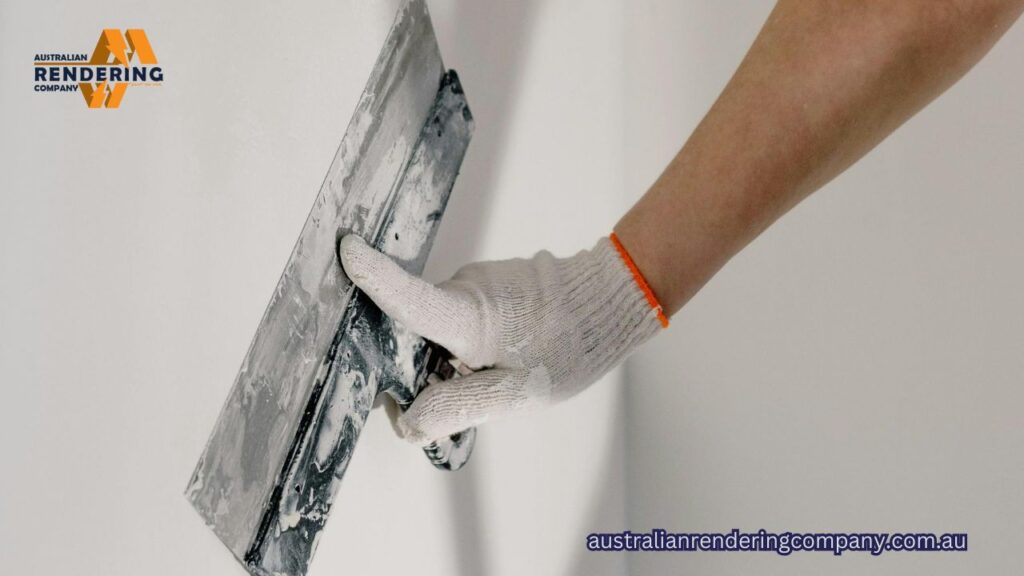Rendering is a common way to protect and improve the look of walls. It uses a mix of cement, sand, and other materials to create a smooth or textured finish.
Painting a rendered wall is a great way to update your home’s look and add extra protection. Australian Rendering Company has over 30 years of experience. They offer durable, clean finishes for new homes, renovations, and repairs, with a 7-year warranty.
By choosing the right paint and application method, homeowners can enjoy a refreshed exterior. It will look good and be protected from the weather.
Can You Paint Over Render?
Many homeowners wonder if they can paint over render. The answer is yes, but it depends on the render type and condition. Painting can make your home look better and protect the render from the weather.
Before painting, it’s key to know the render type and if it’s good for painting.
Types of Render That Accept Paint
Not all renders can be painted. The most common ones that can are:
- Cement-based renders: These are common in Australia and can be painted once they’re fully dry.
- Acrylic-based renders: These are flexible and can be painted with the right paint.
- Lime-based renders: These need special care and paints that let air through to keep them in good shape.
Knowing your render type is important before you paint.
Benefits of Painting Rendered Surfaces
Painting rendered surfaces has many advantages, including:
- Improved aesthetics: A new paint job can make your home look much better.
- Protection from the elements: Paint helps keep the render safe from weather damage.
- Increased durability: The right paint can make your render last longer.
Choosing the right paint and preparation can give you a beautiful and lasting finish.
Preparing Rendered Surfaces for Painting
To get a lasting paint job, you must prepare your rendered surfaces right. The right prep is key for a finish that lasts on your house’s exterior.
Assessing the Condition of Your Render
First, check your render’s condition to spot any damage or repairs needed. Look for cracks, holes, or wear. Inspecting your render well will show you what prep steps are needed.
Cleaning and Repairing Rendered Walls
Cleaning your rendered walls is vital for a good paint job. Use a gentle cleaning solution to wipe away dirt, grime, or efflorescence. For fixes, apply a render repair mix to cracks and holes, then sand it smooth.

Priming Requirements for Different Renders
The type of render you have will decide on priming needs. For instance, cement-based renders might need a primer to bond well with paint. Talk to a pro to find the right primer for your render.
By doing these steps, you’ll get a beautifully painted rendered surface. It will last for years, making your painting rendered house exterior project a hit.
Best Paint Types for Rendered Surfaces
Choosing the right paint for rendered surfaces is key for a lasting and good-looking finish. Rendered surfaces need paints that can handle different weather conditions. This is very important in Australia’s varied climate.
Masonry and Exterior Paints for Australian Conditions
Masonry paints, like silicone-based or acrylic paints, are great for rendered walls. Silicone-based paints are water-resistant and breathable, making them ideal for modern homes. Acrylic paints are a more affordable choice with good durability.
- Silicone-based paints for superior water resistance
- Acrylic paints for a cost-effective solution
Breathable Paint Options
Breathable paints are vital for rendered surfaces to stop moisture buildup. Silicone-based paints are a top pick because they are breathable and water-resistant.
Colour Considerations for Rendered Walls

When picking a colour, think about the external environment and architectural style. Lighter colours can reflect heat, while darker colours absorb it.
- Consider the surroundings and architectural style
- Choose colours that reflect or absorb heat as needed
Step-by-Step Guide to Painting Over Render
Painting over render can change your walls inside or outside. This guide will show you how to do it right.
Tools and Materials Needed
You’ll need specific tools and materials for painting over render. You’ll need a primer for masonry surfaces, exterior-grade paint for rendered walls, and synthetic-bristled paintbrushes. Also, get a roller with an extension pole for big areas. Don’t forget a cleaning solution and masking tape for edges and trim.
Application Techniques
Choosing the right painting method is key. You can use brush, roller, or spray application.
Brush Application
Brushes are great for small areas and detail work. They give you control, perfect for edges and corners.
Roller Application
Rollers work well for big surfaces. They give a smooth finish. Use an extension pole to avoid ladders.
Spray Application
Spray painting gives a uniform finish. It’s good for big, complex areas. But, you must mask nearby areas to avoid overspray.
Drying Times and Second Coats
Wait for the first coat to dry before adding a second. The drying time depends on the paint and the weather. Exterior paints usually take hours to dry. Check the finish after the first coat. If it’s not right, add a second coat for the color and coverage you want.
Common Problems When Painting Render
Painting render can make a property look better. But, there are problems that can happen. Homeowners and professionals need to know these issues to get good results.
Dealing with Efflorescence
Efflorescence is a white salt deposit on surfaces. It’s a big problem when painting render. Clean the area well before painting. Use a wire brush to get rid of the salt. Then, mix water and vinegar to neutralize the surface.
Preventing Peeling and Flaking
Peeling and flaking happen if the surface isn’t prepared right or if the wrong paint is used. To stop this, make sure the render is fully cured and clean. Choose a high-quality masonry paint that’s right for render.
Addressing Moisture Issues in Australian Climate
Moisture is a big problem when painting render, more so in Australia’s climate. Use paints that breathe. This lets moisture out, preventing damage to the paint.
Fixing Cracks and Damage Before Painting
Cracks and damage need fixing before painting. Use a render repair mix to fill in cracks and damaged spots. Sand it smooth before painting.
Knowing and fixing these common problems helps get a lasting paint job on rendered surfaces.
Professional vs DIY Render Painting
It’s important to know the pros and cons of DIY versus professional render painting. When thinking about painting over rendered walls, consider the advantages and disadvantages of each method.
DIY projects can save money and be rewarding. But, there are times when hiring a pro is better. This is true for big jobs or areas that need special tools and skills.
When to Call the Professionals
If your rendered walls have big damage, like deep cracks or widespread salt stains, get a pro. They can check the damage and use the best paint for rendering for a lasting finish.
Also, if you’re not sure about the paint type or lack experience, experts can help. They offer advice and services.
Cost Comparison and Value Considerations
The cost of DIY versus hiring a pro is different. DIY might seem cheaper at first, but think about material costs, possible mistakes, and your time. Pros might cost more but offer warranties and guarantees for long-term benefits.
When choosing, think about the job’s complexity, the area to be painted, and future upkeep. This is important when can you paint over render is a question.
Extending the Life of Your Painted Render
To keep your painted rendered house exterior looking its best, regular maintenance is key. Clean your rendered walls once a year with a mild detergent and water. This removes dirt and debris, keeping them looking good.
When painting exterior rendered walls, check for cracks or peeling paint often. Fixing these spots as you go stops moisture damage. Following these tips helps your painted render last longer.
Wondering if you can use masonry paint on render? Yes, but make sure it’s right for your render. Regular checks and upkeep spot issues early. This lets you fix them before they get worse.
Can you paint over render?
Yes, you can paint over render. But, you must prepare the surface well and pick the right paint.
What type of render can be painted?
Most renders can be painted. This includes cement, acrylic, and silicone-based ones. Always check the render’s condition and type first.
Do I need to prime my rendered walls before painting?
Yes, priming is key for a strong bond between the render and paint. The right primer depends on the render and paint types.
What is the best paint for rendering?
Use masonry or exterior paints for rendering. Choose breathable paints to avoid moisture buildup. Opt for paints made for Australian weather.
Can I use masonry paint on render?
Yes, masonry paint works on render. Just make sure it matches the render type and follow the instructions.
How do I prepare my rendered surface for painting?
First, check the render’s condition. Clean and fix any damage. Then, prime if needed.
Can I paint over pebbledash render?
Yes, you can paint over pebbledash. But, clean and prepare the surface well for a smooth finish.
What are the benefits of painting rendered surfaces?
Painting improves looks, protects from weather, and makes surfaces last longer.
How often should I inspect and maintain my painted render?
Check and clean your painted render often. This prevents damage and keeps it looking good. Do touch-ups and repairs as needed.
Should I hire a professional to paint my rendered walls?
Think about hiring a pro if you’re not sure about preparing the surface or choosing paint. They can give expert advice and ensure a great finish.




